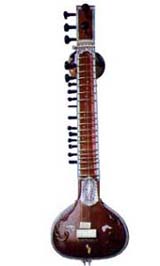Sitar

From the Persian seh = three, tar = strings: the name notwithstanding, most scholars point to the tri-tantri vina, a lute-like instrument mentioned by Sharangdev. Others refer to an origin traceable to Amir Khusro who allegedly reversed the strings of an instrument, thus creating the sitar! There is certainty on the present sitar emerging in the eighteenth century and the addition of three extra strings to the existing three.
The vina influenced the structure and additions - the metal frets, the bridge and the use of the mizrab to play the sitar.
